Importance of Environmental Measures Under the CAP 2023–2027 on High Nature Value Farmlands: Evidence from Poland
Abstract
1. Introduction
2. Materials and Methods
- with at least 50% of agricultural land located on farms participating in eco-schemes,
- with at least 25% of agricultural land under organic farming measures,
- with at least 25% of agricultural land covered by agri-environment-climate measures.
- pi—the share of the area of a given crop i—of this species (i = 1) in the sown area,
- lnpi—the natural logarithm of i—that share of a given plant species in the arable land,
- s—sum of products pi and lnpi
- an exceptionally high share of HNVf areas (at least 75% of total agricultural land),
- an average share of HNVf areas (25–75%), and
- a low share of HNVf areas (less than 25%).
3. Results
3.1. Agriculture with Different Saturation of Environmental Measures Under the CAP 2023–2027 in Poland
3.2. HNVf Areas Versus Implementation of Environmental Measures Under the CAP 2023–2027
3.2.1. HNVf Areas Versus Eco-Scheme Measures
3.2.2. HNVf Areas Versus Organic Farming and Agri-Environment-Climate Measures
4. Discussion
5. Conclusions
- Municipalities with a particularly high share of HNVf, regardless of its ecological value, exhibit a distinct land use structure compared to other areas. These municipalities are characterized by a significantly lower share of arable land and a higher proportion of permanent grasslands. This is largely due to natural constraints that limit agricultural potential.
- Challenging environmental conditions in HNVf areas, such as steep slopes, poor soil quality and shorter vegetation periods, limit the range of crops that can be cultivated profitably. As a result, these areas have lower levels of crop diversification, particularly in mountainous and sub-mountainous regions, as reflected by low Shannon–Wiener (S–W) indices for arable land.
- Municipalities with a high share of land under eco-schemes differ in land use structure from those with high involvement in organic farming or agri-environment-climate interventions. The former have a higher proportion of arable land and a lower share of permanent grasslands, indicating different production profiles and varying capacities to adopt specific environmental practices.
- 1/3 of the total farms in Poland applied for eco-scheme payments in the first year of the CAP 2023–2027. The uptake of specific eco-scheme practices was the lowest in municipalities with a high share of HNVf, suggesting a mismatch between certain eco-scheme requirements and the conditions of HNVf farming systems.
- Environmental interventions (agri-environment-climate measures, organic farming) play a much more significant role in municipalities with high concentrations of HNVf, particularly in areas of high or exceptional high environmental value. In these municipalities, the total area covered by such interventions often exceeds 20% of the utilized agricultural area, compared to less than 10% in municipalities with a low HNVf presence (<25%).
- Municipalities with high uptake of environmental interventions also tend to have farms with larger average agricultural land areas, which may indicate greater capacity to implement voluntary practices supported under the CAP.
Author Contributions
Funding
Institutional Review Board Statement
Informed Consent Statement
Data Availability Statement
Conflicts of Interest
References
- WEF. The Global Risks Report 2025 20th Edition; World Economic Forum: Geneva, Switzerland, 2025; Available online: https://reports.weforum.org/docs/WEF_Global_Risks_Report_2025.pdf (accessed on 25 August 2025).
- Communication from the Commission to the European Parliament, the European Council, the Council, the European Economic and Social Committee and the Committee of the Regions. Forging a Climate—Resilient Europe the New EU Strategy on Adaptation to Climate Change, COM (2021b) 82 Final. Available online: https://eur-lex.europa.eu/legal-content/EN/TXT/?uri=COM%3A2021%3A82%3AFIN (accessed on 25 August 2025).
- Morel, A.C.; Hirons, M.; Demissie, S.; Gonfa, T.; Mehrabi, Z.; Long, P.R.; Rifai, S.; Woldemariam Gole, T.; Mason, J.; McDermott, C.L.; et al. The structures underpinning vulnerability: Examining landscape-society interactions in a smallholder coffee agroforestry system. Environ. Res. Lett. 2019, 14, 075006. [Google Scholar] [CrossRef]
- Grzelak, A.; Stępień, S. Konsekwencje zmian klimatycznych dla rolnictwa-wybrane problemy. In Agroekonomia w Warunkach Rynkowych. Problemy i Wyzwania; Grzelak, A., Sapa, A., Eds.; Wydawnictwo Uniwersytetu Ekonomicznego w Poznaniu: Poznań, Poland, 2010. [Google Scholar]
- Tilman, D.; Cassman, K.; Matson, P.A.; Naylor, R.; Polasky, S. Agricultural sustainability and intensive production practices. Nature 2002, 418, 671–677. [Google Scholar] [CrossRef]
- Bennett, E.M.; Baird, J.; Baulch, H.; Chaplin-Kramer, R.; Fraser, E.; Loring, P.; Morrison, P.; Parrott, L.; Sherren, K.; Winkler, K.J.; et al. Chapter One—Ecosystem services and the resilience of agricultural landscapes. In Advances in Ecological Research; David, A., Bohan, A., Vanbergen, J., Eds.; Academic Press: Oxford, UK, 2021; Volume 64, pp. 1–43. [Google Scholar] [CrossRef]
- FAO. The State of the World’s Land and Water Resources for Food and Agriculture 2021; Main Report; Food and Agriculture Organization of the United Nations: Rome, Italy, 2022. [Google Scholar]
- Stagnari, F.; Sumira, J.; Galieni, A.; Pisante, M. Chapter 6—Sustainable Agricultural Practices For Water. In Water Stress and Crop Plants: A Sustainable Approach, 1st ed.; Parvaiz, A., Ed.; Wiley: Hoboken, NJ, USA, 2016; Volume 1, pp. 75–86. [Google Scholar]
- Ayub, M.A.; Usman, M.; Faiz, T.; Umair, M.; ul Haq, M.A.; Rizwan, M.; Ali, S.; Zia ur Rehman, M. Restoration of Degraded Soil for Sustainable Agriculture. In Soil Health Restoration and Management; Springer Singapore: Singapore, 2019; pp. 31–81. [Google Scholar] [CrossRef]
- Wang, M.-X.; Liang, L.-N.; Siu, W.S.; Fan, D.; Sun, H.-R.; Zhao, H.-H.; Zhou, G.-J.; Wu, W.-J. Loss accounting of environmental pollution within Pearl River Delta region, South China. Environ. Pollut. 2019, 249, 676–685. [Google Scholar] [CrossRef]
- Abler, D. Multifunctionality, Agricultural Policy, and Environmental Policy. Agric. Resour. Econ. Rev. 2004, 33, 8–17. [Google Scholar] [CrossRef]
- Daniłowska, A. Koncepcja dóbr publicznych a rolnictwo. In Prace Naukowe Uniwersytetu Ekonomicznego we Wrocławiu; Wrocław University of Economics: Wrocław, Poland, 2014; Volume 360. [Google Scholar] [CrossRef][Green Version]
- Moruzzo, R.; Espinosa Diaz, S.; Granai, G.; Di Iacovo, F.; Riccioli, F. Living lab as support for co-creation of value: Application to agro-biodiversity contracting solutions. Local Environ. 2024, 1–14. [Google Scholar] [CrossRef]
- Drucker, A.G.; Pradel, W.; Scott, C.; Elmes, S.; Valero, K.G.A.; Zander, K.K. High Public Good Values for Ecosystem Service Attributes of on-farm Quinoa Diversity Conservation in Peru. Hum. Ecol. 2024, 52, 67–79. [Google Scholar] [CrossRef]
- Thrupp, L.A. The Importance of Biodiversity in Agroecosystems. J. Crop Improv. 2004, 12, 315–337. [Google Scholar] [CrossRef]
- Kumar, C.; Kotra, V.; Kumar, N.; Singh, K.; Singh, A.K. Chapter 8—Biodiversity and bioresources: Impact of biodiversity loss on agricultural sustainability. In Biodiversity and Bioeconomy; Singh, K., Ribeiro, M.C., Calicioglu, Ö., Eds.; Elsevier: Amsterdam, The Netherlands, 2024; pp. 165–198. [Google Scholar] [CrossRef]
- Hailu, F. The role of agrobiodiversity and diverse causes of its losses and methods of conservation. Rev. Food Humanit. 2025, 4, 100500. [Google Scholar] [CrossRef]
- Tenza-Peral, A.; Ripoll-Bosch, R.; Casasús, I.; Martín-Collado, D.; Bernués, A. Chapter 6—Sustaining biodiversity and ecosystem services with agricultural production. In Sustainable Development and Pathways for Food Ecosystems; Accorsi, R., Bhat, R., Eds.; Elsevier: Amsterdam, The Netherlands, 2023; pp. 129–146. [Google Scholar] [CrossRef]
- Arias-Navarro, C.; Baritz, R.; Jones, A. The State of Soils in Europe; JRC137600; Publications Office of the European Union: Luxembourg, 2024. [Google Scholar] [CrossRef]
- Mouysset, L. Reconciling agriculture and biodiversity in European public policies: A bio-economic perspective. Reg. Environ. Change 2017, 17, 1421–1428. [Google Scholar] [CrossRef]
- Mäkeläinen, S.; Harlio, A.; Heikkinen, R.K.; Herzon, I.; Kuussaari, M.; Lepikkö, K.; Maier, A.; Seimola, T.; Tiainen, J.; Arponen, A. Coincidence of High Nature Value farmlands with bird and butterfly diversity. Agric. Ecosyst. Environ. 2019, 269, 224–233. [Google Scholar] [CrossRef]
- Gil-Mendoza, L.G.; Ramírez-Albores, J.E.; Burgara-Estrella, A.J.; García-Hernández, J. Impacts of intensive agriculture on birds: A review. Agrociencia 2024, 58, 118–132. [Google Scholar] [CrossRef]
- Li, L.; Van der Werf, W.; Zhang, F. Crop Diversity and Sustainable Agriculture: Mechanisms, Designs and Applications. Front. Agr. Sci. Eng. 2021, 8, 359–361. [Google Scholar] [CrossRef]
- Feledyn-Szewczyk, B. Wpływ systemów produkcji rolnej na bioróżnorodność i świadczenia ekosystemowe. In Z Badań Nad Rolnictwem Społecznie Zrównoważonym (24); Zegar, J.S., Ed.; Wyd. IERGŻ Warszawa: Warsaw, Poland, 2014; Volume 109, pp. 11–30. ISBN 978-83-7658-488-1. [Google Scholar]
- Maney, C.; Sassen, M.; Ken, G.E. Are agricultural commodity production systems at risk from local biodiversity loss? Biol. Lett. 2024, 20, 2020240283. [Google Scholar] [CrossRef] [PubMed]
- Gorynia, M. Nauki ekonomiczne a postulat interdyscyplinarności. In Ekonomia i Środowisko. Księga Jubileuszowa. Profesora Bogusława Fiedora; Czaja, S., Graczyk, A., Eds.; Wydawnictwo Uniwersytetu Ekonomicznego we Wrocławiu: Wrocław, Poland, 2016. [Google Scholar]
- Wilkin, J. Nauka przekracza wszelkie granice, także w ekonomii. In Ewolucja Nauk Ekonomicznych. Jedność a Różnorodność, Relacje do Innych Nauk, Problemy Klasyfikacyjne; Gorynia, M., Ed.; IRWiR PAN: Warsaw, Poland, 2019; Volume 57–68, Available online: https://publikacje.pan.pl/book/131636/ewolucja-nauk-ekonomicznych-jednosc-a-roznorodnosc-relacje-do-innych-nauk-problemy-klasyfikacyjne (accessed on 25 August 2025).
- Wuepper, D.; Bukchin-Peles, S.; Just, D.; Zilberman, D. Behavioral agricultural economics. Appl. Econ. Perspect. Policy 2023, 45, 2094–2105. [Google Scholar] [CrossRef]
- Sadłowski, A.; Wrzaszcz, W.; Smędzik-Ambroży, K.; Matras-Bolibok, A.; Budzyńska, A.; Angowski, M.; Mann, S. Direct Payments and Sustainable Agricultural Development—The Example of Poland. Sustainability 2021, 13, 13090. [Google Scholar] [CrossRef]
- Wrzaszcz, W.; Prandecki, K. Rolnictwo a Zielony Ład. Zagadnienia Ekon. Rolnej Probl. Agric. Econ. 2020, 365, 156–179. [Google Scholar] [CrossRef]
- Rosa, A.; Pawłowska, A.; Dudek, M. Eco-Scheme—Carbon Farming and Nutrient Management—A New Tool to Support Sustainable Agriculture in Poland. Sustainability 2025, 17, 5067. [Google Scholar] [CrossRef]
- EC. Approved 28 CAP Strategic Plans (2023–2027). 2023. Available online: https://agriculture.ec.europa.eu/document/download/7b3a0485-c335-4e1b-a53a-9fe3733ca48f_en?filename=approved-28-cap-strategic-plans-2023-27.pdf (accessed on 25 March 2025).
- EP. Official Journal of the European Union. 2021. Regulation (EU) 2021/2115 of the European Parliament and of the Council of 2 December 2021 Establishing Rules on Support for Strategic Plans to Be Drawn up by Member States Under the Common Agricultural Policy (CAP Strategic Plans) and Financed by the European Agricultural Guarantee Fund (EAGF) and by the European Agricultural Fund for Rural Development (EAFRD) and Repealing Regulations (EU) No 1305/2013 and (EU) No 1307/2013. 2023. Available online: https://eur-lex.europa.eu/legal-content/EN/TXT/PDF/?uri=CELEX:32021R2115 (accessed on 25 August 2025).
- Wuczyński, A.; Dajdok, Z.; Wierzcholska, S.; Kujawa, K. Applying red lists to the evaluation of agricultural habitat: Regular occurrence of threatened birds, vascular plants, and bryophytes in field margins of Poland. Biodivers. Conserv. 2014, 23, 999–1017. [Google Scholar] [CrossRef]
- EC. Eco-Schemes. 2024. Available online: https://agriculture.ec.europa.eu/common-agricultural-policy/income-support/eco-schemes_en (accessed on 25 August 2025).
- Clark, S. Organic Farming and Climate Change: The Need for Innovation. Sustainability 2020, 12, 7012. [Google Scholar] [CrossRef]
- Biswas, S.; Das, R. Organic farming to mitigate biotic stresses under climate change scenario. Bull. Natl. Res. Cent. 2024, 48, 71. [Google Scholar] [CrossRef]
- Benedetti, Y. Trends in High Nature Value farmland studies: A systematic review. Eur. J. Ecol. 2017, 3, 19–32. [Google Scholar] [CrossRef]
- Gardi, C.; Visioli, G.; Conti, F.D.; Scotti, M.; Menta, C.; Bodini, A. High Nature Value Farmland: Assessment of Soil Organic Carbon in Europe. Front. Environ. Sci. 2016, 4, 47. [Google Scholar] [CrossRef]
- Paracchini, M.L.; Petersen, J.E.; Hoogeveen, Y.; Bamps, C.; Burfield, I.; Swaay, C. High Nature Value Farmland in Europe: An Estimate of the Distribution Patterns on the Basis of Land Cover and Biodiversity Data; Publications Office of the European Union: Luxembourg, 2008. [Google Scholar] [CrossRef]
- Andersen, E.; Baldock, D.; Bennett, H.; Beaufoy, G.; Bignal, E.M.; Brouwer, F.; Elbersen, B.; Eiden, G.; Godesschalk, F.; Jones, G.; et al. Developing a High Nature Value Farming Area Indicator. Internal Report for the European Environment Agency; IEEP: London, UK, 2003. [Google Scholar]
- EEA Report. High Nature Value Farmland Characteristics, Trends and Policy Challenges; European Environment Agency: Copenhagen, Denmark, 2004; Volume 1, Available online: https://www.eea.europa.eu/en/analysis/publications/report_2004_1 (accessed on 25 August 2025).
- Pardo, I.; Zabalza, S.; Berastegi, A.; Ripoll-Bosch, R.; Astrain, C. Assessment of determinants of high nature value (HNV) farmland at plot scale in Western Pyrenees. J. Environ. Manag. 2024, 349, 119516. [Google Scholar] [CrossRef] [PubMed]
- Zomeni, M.; Martinou, A.F.; Stavrinides, M.C.; Vogiatzakis, I.N. High nature value farmlands: Challenges in identification and interpretation using Cyprus as a case study. Nat. Conserv. 2018, 31, 53–70. [Google Scholar] [CrossRef]
- Buchadas, A.; Moreira, F.; McCracken, D.; Santos, J.L.; Lomba, A. Assessing the potential delivery of ecosystem services by farmlands under contrasting management intensities. Ecol. Soc. 2022, 27, 5. [Google Scholar] [CrossRef]
- Sullivan, C.A.; Finn, J.A.; Ó Huallacháin, D.; Green, S.; Matin, S.; Meredith, D.; Clifford, B.; Moran, J. The development of a national typology for High Nature Value farmland in Ireland based on farm-scale characteristics. Land Use Policy 2017, 67, 401–414. [Google Scholar] [CrossRef]
- Kampf, H. From domestication to de-domestication: Managing of vegetation using large herbivores. In Proceedings of the Sixth European Forum on Nature Conservation and Pastoralism, Prague, Czech Republic, 19–26 July 1998; pp. 42–54. [Google Scholar]
- Tyburski, J. Dzika bioróżnorodność ekosystemów rolnych i metody jej ochrony. In Biologiczna Różnorodność Ekosystemów Rolnych Oraz Możliwości Jej Ochrony w Gospodarstwach Ekologicznych; Tyburski, J., Kostrzewska, M., Eds.; UWM w Olsztynie: Olsztyn, Poland, 2013; pp. 279–291. [Google Scholar]
- Baldock, D. Indicators for High Nature Value Farming Systems in Europe. In Environmental Indicators and Agricultural Policy; Brouwer, F.M., Crabtree, J.R., Eds.; CAB International: Wallingford, UK, 1999; pp. 121–135. [Google Scholar] [CrossRef]
- Beaufoy, G. HNV Farming-Explaining the concept and interpreting EU and national policy commitments. In Proceedings of the European Forum on Nature Conservation and Pastoralism, Gjerstad, Norway, 8–11 June 2014; pp. 1–15. Available online: http://www.efncp.org/download/EFNCP-HNV-farming-concept.pdf (accessed on 25 August 2025).
- Moran, J.; Byrne, D.; Carlier, J.; Dunford, B.; Finn, J.A.; Ó Huallacháin, D.; Sullivan, C.A. Management of high nature value farmland in the Republic of Ireland: 25 years are evolving toward locally adapted results-orientated solutions and payments. Ecol. Soc. 2021, 26, 20. [Google Scholar] [CrossRef]
- Overmars, K.P.; Helming, J.; van Zeijts, H.; Jansson, T.; Terluin, I. A modelling approach for the assessment of the effects of Common Agricultural Policy measures on farmland biodiversity in the EU27. J. Environ. Manag. 2013, 126, 132–141. [Google Scholar] [CrossRef]
- Veen, J. The ornithological values of grasslands in relation to modern dairy farming: A conflict. In Proceedings of the Agriculture and Nature Conservation in Central and Eastern Europe Countries, Dębe, Poland, 12–14 May 1996. [Google Scholar]
- Vera, F.; Bakker, E.; Olff, H. Large herbivores: Missing partners of western European light-demanding tree and shrub species? In Large Herbivore Ecology, Ecosystem Dynamics and Conservation; Cambridge University Press: Cambridge, UK, 2006; pp. 203–231. [Google Scholar] [CrossRef]
- Rosin, Z.M.; Pärt, T.; Low, M.; Kotowska, D.; Tobolka, M.; Szymański, P.; Hiron, M. Village modernization may contribute more to farmland bird declines than agricultural intensification. Conserv. Lett. 2021, 14, e12843. [Google Scholar] [CrossRef]
- Wuczyński, A.; Kujawa, K.; Dajdok, Z.; Grzesiak, W. Species richness and composition of bird communities in various field margins of Poland. Agric. Ecosyst. Environ. 2011, 141, 202–209. [Google Scholar] [CrossRef]
- Knozowski, P.; Nowakowski, J.J.; Stawicka, A.M.; Górski, A.; Dulisz, B. Effect of nature protection and management of grassland on biodiversity—Case from big flooded river valley (NE Poland). Sci. Total Environ. 2023, 898, 165280. [Google Scholar] [CrossRef] [PubMed]
- European Commission (EC). The Working Document Practices to Identify, Monitor and Assess HNV Farming in RDPs 2014–2020 in Order to Better Shaping the CAP in the EU. Available online: https://ec.europa.eu/enrd/evaluation/publications/practices-identify-monitor-and-assess-hnv-farming-rdps-2014-2020_pl.html (accessed on 25 August 2025).
- Jadczyszyn, J.; Zieliński, M. Assessment of farms from High Nature Value Farmland areas in Poland. Ann. Pol. Assoc. Agric. Agribus. Econ. 2020, 22, 108–118. [Google Scholar] [CrossRef]
- Matyka, M. Ocena regionalnego zróżnicowania struktury zasiewów w kontekście oddziaływania na środowisko przyrodnicze. Rocz. Nauk. Ser. 2017, 19, 188–192. [Google Scholar] [CrossRef]
- Zieliński, M.; Jadczyszyn, J. Importance and challenges for agriculture from High Nature Value farmlands (HNVf) in Poland in the context of the provision of public goods under the European Green Deal. Econ. Environ. 2022, 82, 194–219. [Google Scholar] [CrossRef]
- Benzler, A. Drawing on National Experience for Identifying HNV Farmland at European Scale: HNV Farmland Monitoring in Germany. Presented at Expert workshop “Revising the JRC/EEA EU-level HNV Farmland Methodology” [Online], Vienna, Austria, 12 June 2017. Available online: https://ec.europa.eu/enrd/evaluation/european-evaluation-helpdesk-rural-development/good-practice-workshops/preparing_en.html (accessed on 11 November 2024).
- Hünig, C.; Benzler, A. Das Monitoring der Landwirtschaftsflachen mit Hohem Naturwert in Deutchland; BfN-Skripten 476; Bundesamt für Naturschutz: Bonn, Germany, 2017. [Google Scholar] [CrossRef]
- Sullivan, C.; Moran, J. High nature value farmland management: Innovative approaches to sustainability of HNV grassland systems in Ireland. In Grassland Resources for Extensive Farming Systems in Marginal Lands: Major Drivers and Future Scenarios; CNR-ISPAAM: Sassari, Italy, 2017; p. 428. [Google Scholar]
- Trisorio, A.; Archinto, D. Monitoring biodiversity: Challenges in High Nature Value farming identification. Ital. Rev. Agric. Econ. 2019, 74, 43–52. [Google Scholar]
- Zieliński, M.; Gołębiewska, B.; Adamski, M.; Sobierajewska, J.; Tyburski, J. Adaptation of eco-schemes to Polish agriculture in the first year of the EU CAP 2023–2027. Econ. Environ. 2024, 89, 817. [Google Scholar] [CrossRef]
- Cagliero, R.; Vassallo, M.; Pierangeli, F.; Pupo D’Andrea, M.R.; Monteleone, A.; Camaioni, B.; Tarangioli, S. The Common Agricultural Policy 2023–2027. How Member States Implement the New Delivery Model? Ital. Rev. Agric. Econ. 2023, 78, 49–66. [Google Scholar] [CrossRef]
- Ziętara, W.; Mirkowska, Z. The Green Deal: Towards Organic Farming or Greening of Agriculture? Probl. Agric. Econ. 2021, 368, 29–54. [Google Scholar] [CrossRef]
- Castillo-Diaz, F.J.; Belmonte-Urena, L.J.; Alvarez-Rodriguez, J.F.; Cachao-Ferre, F. Role of Sustainability and Circural Economy in Europe’s Common Agricultural Policy. In Environmentally Sustainable Production. Research for Sustainable Development; Valls Martinez, M.d.C., Santos-Jaen, J.M., Eds.; Springer: Cham, Switzerland, 2024; pp. 9–84. [Google Scholar]
- Zieliński, M. Instytucje a Rolnictwo na Obszarach z Ograniczeniami Naturalnymi; IAFE NRI: Warsaw, Poland, 2024; Available online: http://ierigz.waw.pl/publikacje/studia-i-monografie/25634,7,3,0,nr-200-instytucje-a-rolnictwo-na-obszarach-z-ograniczeniami-naturalnymi.html (accessed on 25 January 2025).
- Lomba, A.; Strohbach, M.; Jerrentrup, J.S.; Dauber, J.; Klimek, S.; McCracken, D.I. Making the best of both worlds: Can high-resolution agricultural administrative data support the assessment of High Nature Value farmlands across Europe? Ecol. Indic. 2017, 72, 118–130. [Google Scholar] [CrossRef]
- Morelli, F.; Girardello, M. Buntings (Emberizidae) as indicators of HNV of farmlands: A case of study in Central Italy. Ethol. Ecol. Evol. 2014, 26, 405–412. [Google Scholar] [CrossRef]
- Morelli, F.; Jerzak, L.; Tryjanowski, P. Birds as useful indicators of high nature value (HNV) farmland in Central Italy. Ecol. Indic. 2014, 38, 236–242. [Google Scholar] [CrossRef]
- Bernard, C.; Poux, X.; Herzon, I.; Moran, J.; Dumitras, D.E.; Ferraz-de-Oliveira, M.I.; Gouriveau, F.; Goussios, D.; Jitea, M.I.; Kazakova, Y.; et al. Innovation brokers in High Nature Value farming areas: A strategic approach to engage effective socioeconomic and agroecological dynamics. Ecol. Soc. 2023, 28, 20. [Google Scholar] [CrossRef]
- Ribeiro, P.F.; Nunes, L.C.; Beja, P.; Reino, L.; Santana, J.; Moreira, F.; Santos, J.L. A Spatially Explicit Choice Model to Assess the Impact of Conservation Policy on High Nature Value Farming Systems. Ecol. Econ. 2018, 145, 331–338. [Google Scholar] [CrossRef]
- Azeda, C.; Guiomar, N.; Godinho, S.; Medeiros, J.P.; Pinto-Correia, T. The ambiguous role of agri-environment-climate measures in the safeguarding of High Nature Value Farming Systems: The case of the Montado in Portugal. Agric. Ecosyst. Environ. 2021, 319, 107562. [Google Scholar] [CrossRef]
- O’Rourke, E.; Kramm, N. High nature value (HNV) farming and the management of upland diversity. Rev. Eur. Countrys. 2012, 4, 116–133. [Google Scholar] [CrossRef]
- Jitea, M.I.; Mihai, V.C.; Arion, F.H.; Muresan, I.C.; Dumitras, D.E. Innovation Gaps and Barriers in Alternative Innovative Solutions for Sustainable High Nature Value Grasslands. Evidence from Romania. Agriculture 2021, 11, 235. [Google Scholar] [CrossRef]
- Chapman, M.; Satterfield, T.; Chan, K.M.A. When value conflicts are barriers: Can relational values help explain farmer participation in conservation incentive programs? Land Use Policy 2019, 82, 464–475. [Google Scholar] [CrossRef]
- Osawe, W.; Curtis, J. An assessment of farmers’ knowledge, attitudes and intentions towards water quality and pollution risk mitigation actions. Soc. Sci. Humanit. Open 2024, 9, 100858. [Google Scholar] [CrossRef]
- Baur, I.; Nax, H.H. Measures against the abandonment of common property summer pastures: Experimental evidence from joint appropriation-provision games. Ecol. Soc. 2021, 26, 4. [Google Scholar] [CrossRef]
- Brunbjerg, A.K.; Bladt, J.; Brink, M.; Fredshavn, J.; Mikkelsen, P.; Moeslund, J.E.; Nygaard, B.; Skov, F.; Ejrnæs, R. Development and implementation of a high nature value (HNV) farming indicator for Denmark. Ecol. Indic. 2016, 61, 274–281. [Google Scholar] [CrossRef]
- Guth, M.; Stępień, S.; Smędzik-Ambroży, K.; Matuszczak, A. Is small beautiful? Technical efficiency and environmental sustainability of small-scale family farms under the conditions of agricultural policy support. J. Rural. Stud. 2022, 89, 235–247. [Google Scholar] [CrossRef]
- Taylor, B.M.; Van Grieken, M. Local institutions and farmer participation in agri-environmental schemes. J. Rural. Stud. 2015, 37, 10–19. [Google Scholar] [CrossRef]
- Matin, S.; Sullivan, C.A.; Finn, J.A.; Huallacháin, D.Ó.; Green, S.; Meredith, D.; Moran, J. Assessing the distribution and extent of High Nature Value farmland in the Republic of Ireland. Ecol. Indic. 2020, 108, 105700. [Google Scholar] [CrossRef]
- Belényesi, M.B.; Podmaniczky, L. Delineation of High Nature Value areas in Hungary. Tájökológiai Lapok 2007, 5, 347–362. [Google Scholar]
- Ruas, S.; Finn, J.; Moran, J.; Carlier, J.; Doyle, M.; Huallacháin, D.Ó. Estimated distribution of high nature value forest in the Republic of Ireland. Land Use Policy 2024, 145, 107277. [Google Scholar] [CrossRef]
- Torres-Miralles, M.; Jeanneret, P.; Lamminen, M.; Joly, F.; Dumont, B.; Tuomisto, H.; Herzon, I. High nature value farming systems in Europe: A dataset encompassing the environmental impact assessment of farms and extensive ruminant food products. Data Brief 2025, 58, 111164. [Google Scholar] [CrossRef]
- Roilo, S.; Engler, J.O.; Václavík, T.; Cord, A.F. Landscape-level heterogeneity of agri-environment measures improves habitat suitability for farmland birds. Ecol. Appl. 2022, 33, e2720. [Google Scholar] [CrossRef] [PubMed]
- Ogawa, K.; Garrod, G.; Yagi, H. Sustainability strategies and stakeholder management for upland farming. Land Use Policy 2023, 131, 106707. [Google Scholar] [CrossRef]
- Bullock, J.M.; McCracken, M.E.; Bowes, M.J.; Chapman, R.E.; Graves, A.R.; Hinsley, S.A.; Hutchins, M.G.; Nowakowski, M.; Nicholls, D.J.E.; Oakley, S.; et al. Does agri-environmental management enhance biodiversity and multiple ecosystem services?: A farm-scale experiment. Agric. Ecosyst. Environ. 2021, 320, 107582. [Google Scholar] [CrossRef]
- Klaus, V.H.; Jehle, A.; Richter, F.; Buchmann, N.; Knop, E.; Lüscher, G. Additive effects of two agri-environmental schemes on plant diversity but not on productivity indicators in permanent grasslands in Switzerland. J. Environ. Manag. 2023, 348, 119416. [Google Scholar] [CrossRef]
- Pe’er, G.; Finn, J.A.; Díaz, M.; Birkenstock, M.; Lakner, S.; Röder, N.; Kazakova, Y.; Sumurada, T.; Bezak, T.; Concepcion, E.D.; et al. How can the European Common Agricultural Policy help halt biodiversity loss? Recommendations by over 300 experts. Conserv. Lett. 2022, 15, e12901. [Google Scholar] [CrossRef]
- Röder, N.; Krämer, C.; Grajewski, R.; Lakner, S.; Matthews, A. What is the environmental potential of th; post-2022 common agricultural policy? Land Use Policy 2024, 144, 107219. [Google Scholar] [CrossRef]
- Šumrada, T.; Erjavec, E.; Šilc, U.; Žgajnar, J. Socio-Economic Viability of the High Nature Value Farmland under the CAP 2023–2027: The Case of a Sub-Mediterranean Region in Slovenia. Agriculture 2024, 14, 1699. [Google Scholar] [CrossRef]
- Czajkowski, M.; Zagórska, K.; Letki, N.; Tryjanowski, P.; Wąs, A. Drivers of farmers’ willingness to adopt extensive farming practices in a globally important bird area. Land Use Policy 2021, 107, 104223. [Google Scholar] [CrossRef]
- Urruth, L.M.; Braun Bassi, J.; Chemello, D. Policies to encourage agroforestry in the Southern Atlantic Forest. Land Use Policy 2022, 112, 105802. [Google Scholar] [CrossRef]
- Kalogiannidis, S.; Karafolas, S.; Chatzitheodoridis, F. The Key Role of Cooperatives in Sustainable Agriculture and Agrifood Security: Evidence from Greece. Sustainability 2024, 16, 7202. [Google Scholar] [CrossRef]
- Sun, B.; Wang, X.; Luo, P.; Zhao, Y.; Rijal, M. Importance of Farmers’ Awareness on Ecological Revitalization to Promote Sustainable Development. Sustainability 2024, 16, 10134. [Google Scholar] [CrossRef]
- Zieliński, M.; Józwiak, W.; Żak, A.; Rokicki, T. Development of Eco-Schemes as an Important Environmental Measure in Areas Facing Natural or Other Specific Constraints Under the Common Agriculture Policy 2023–2027: Evidence from Poland. Sustainability 2025, 17, 2781. [Google Scholar] [CrossRef]
- Kamau, E.W.; Gitau, R.; Bett, H.K. Driving transformation: The role of institutions in shaping ecological farming adoption in Kiambu County, Kenya. Dev. Pract. 2025, 35, 101–116. [Google Scholar] [CrossRef]
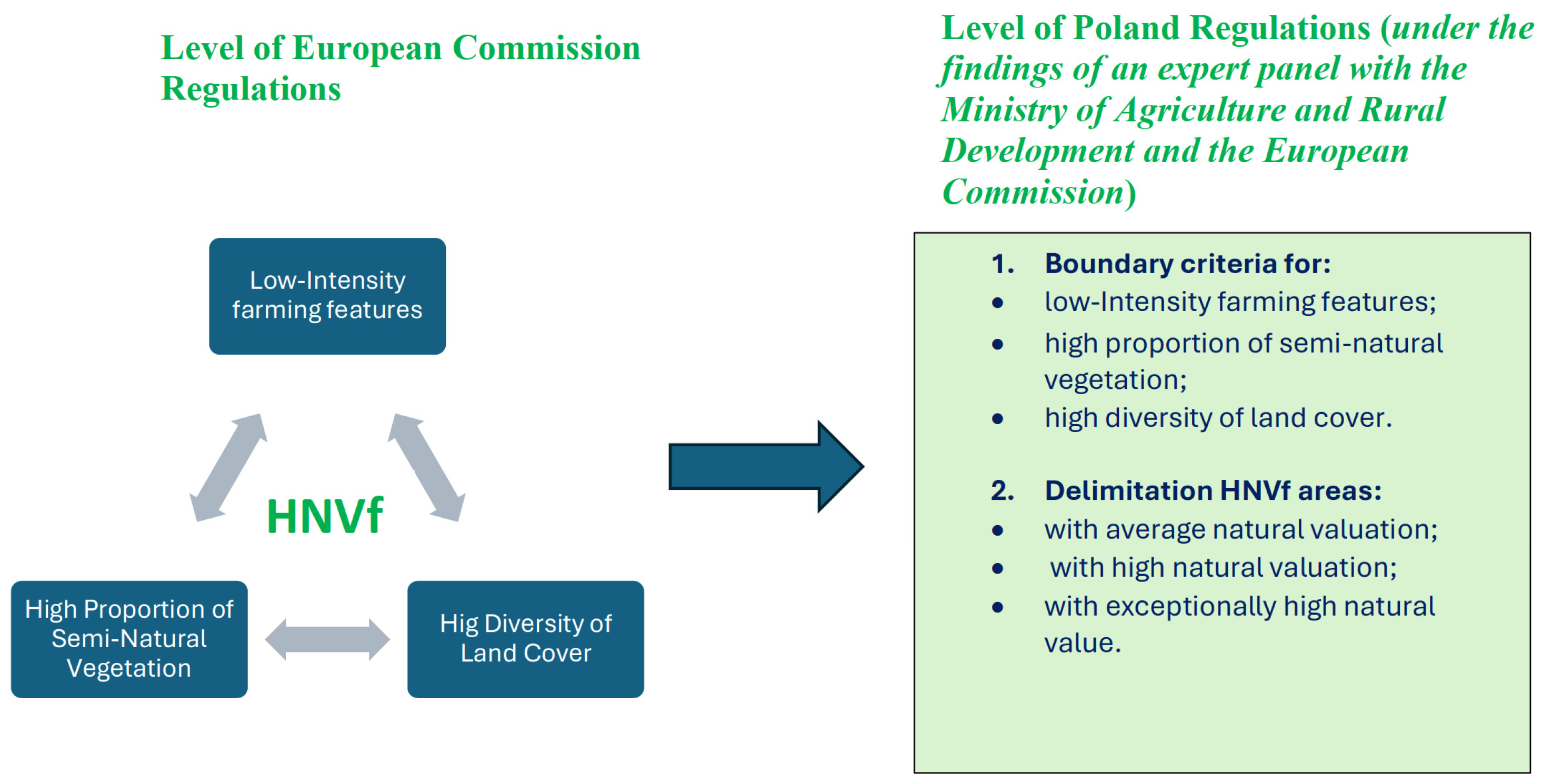
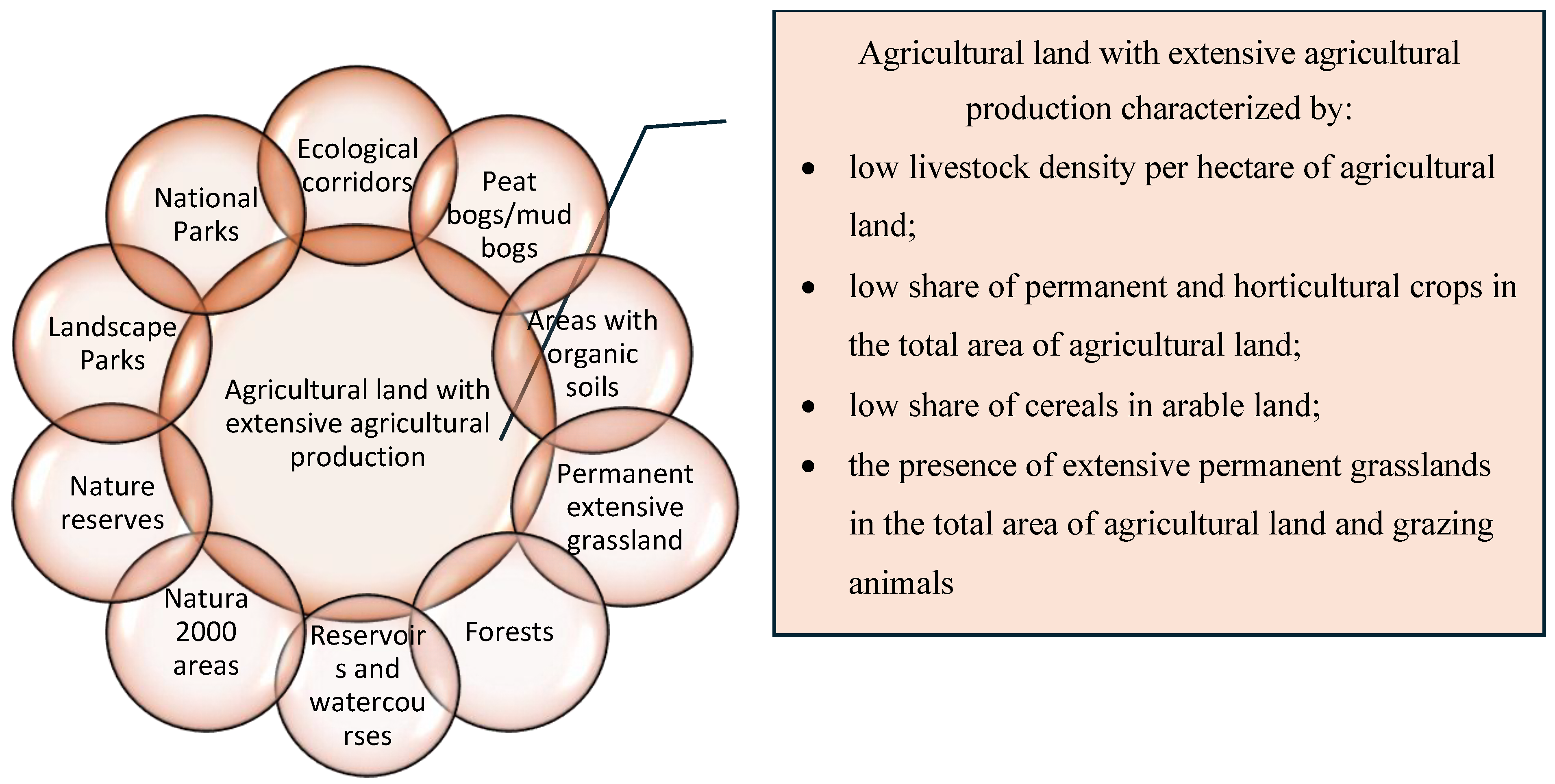


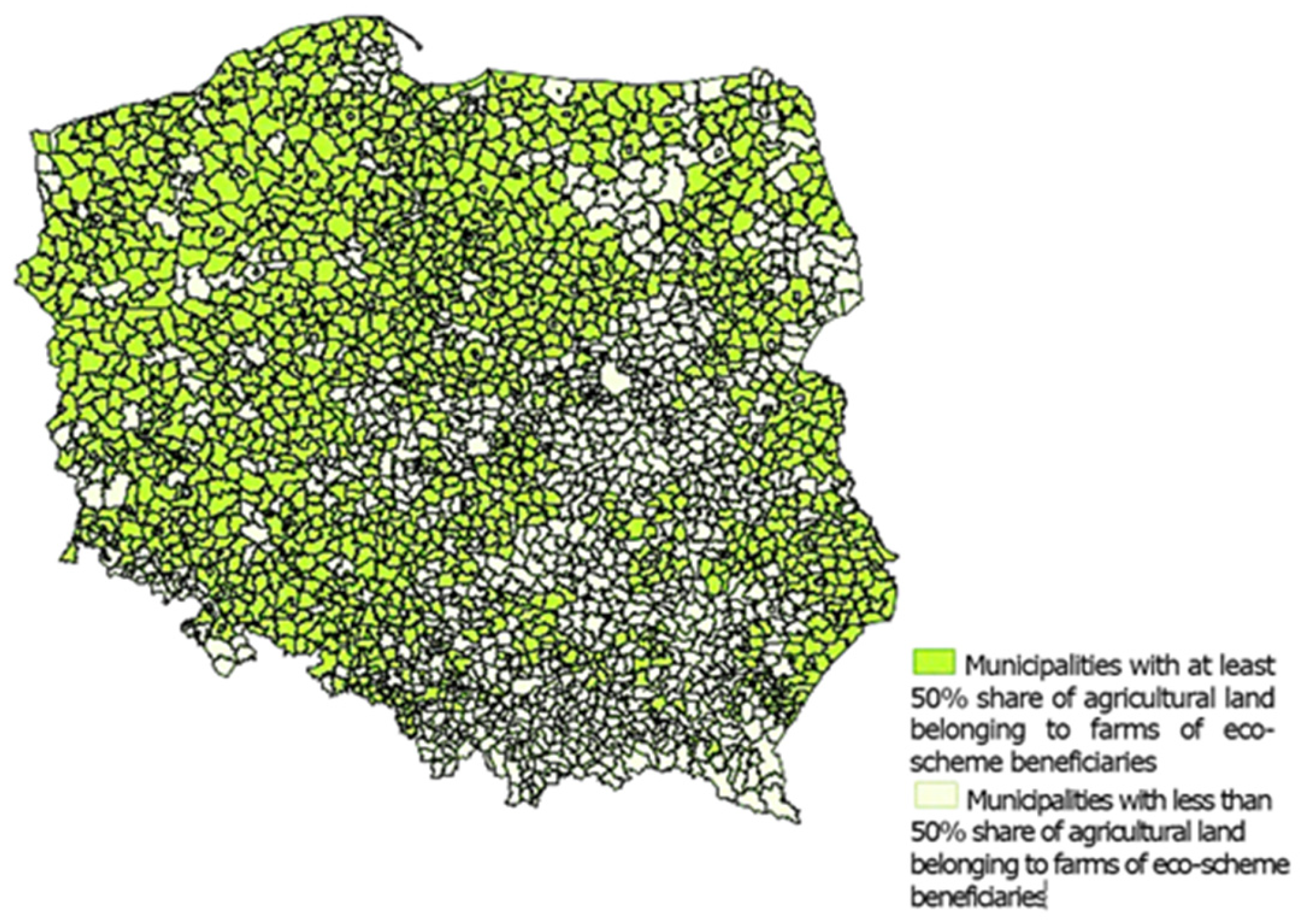
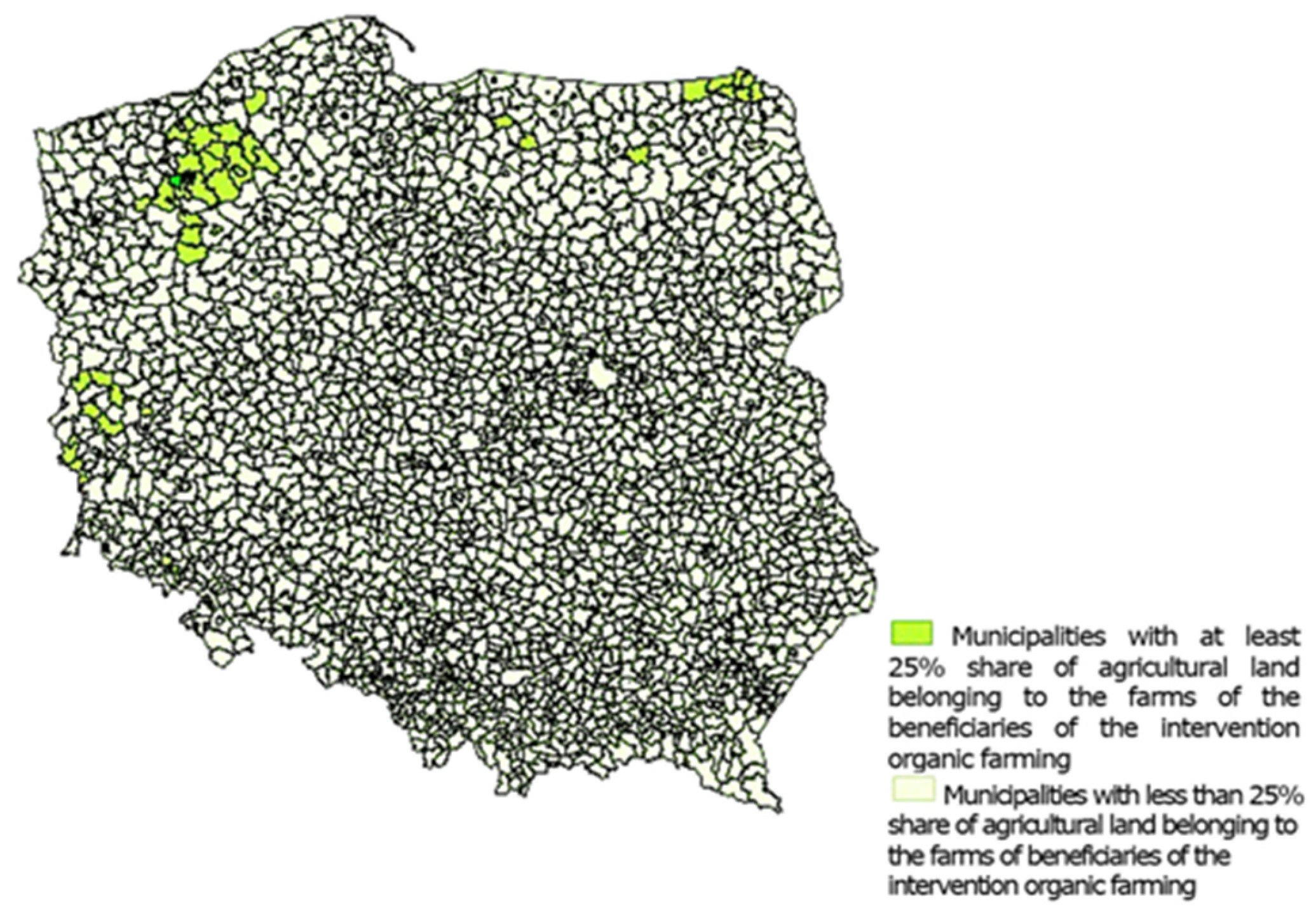
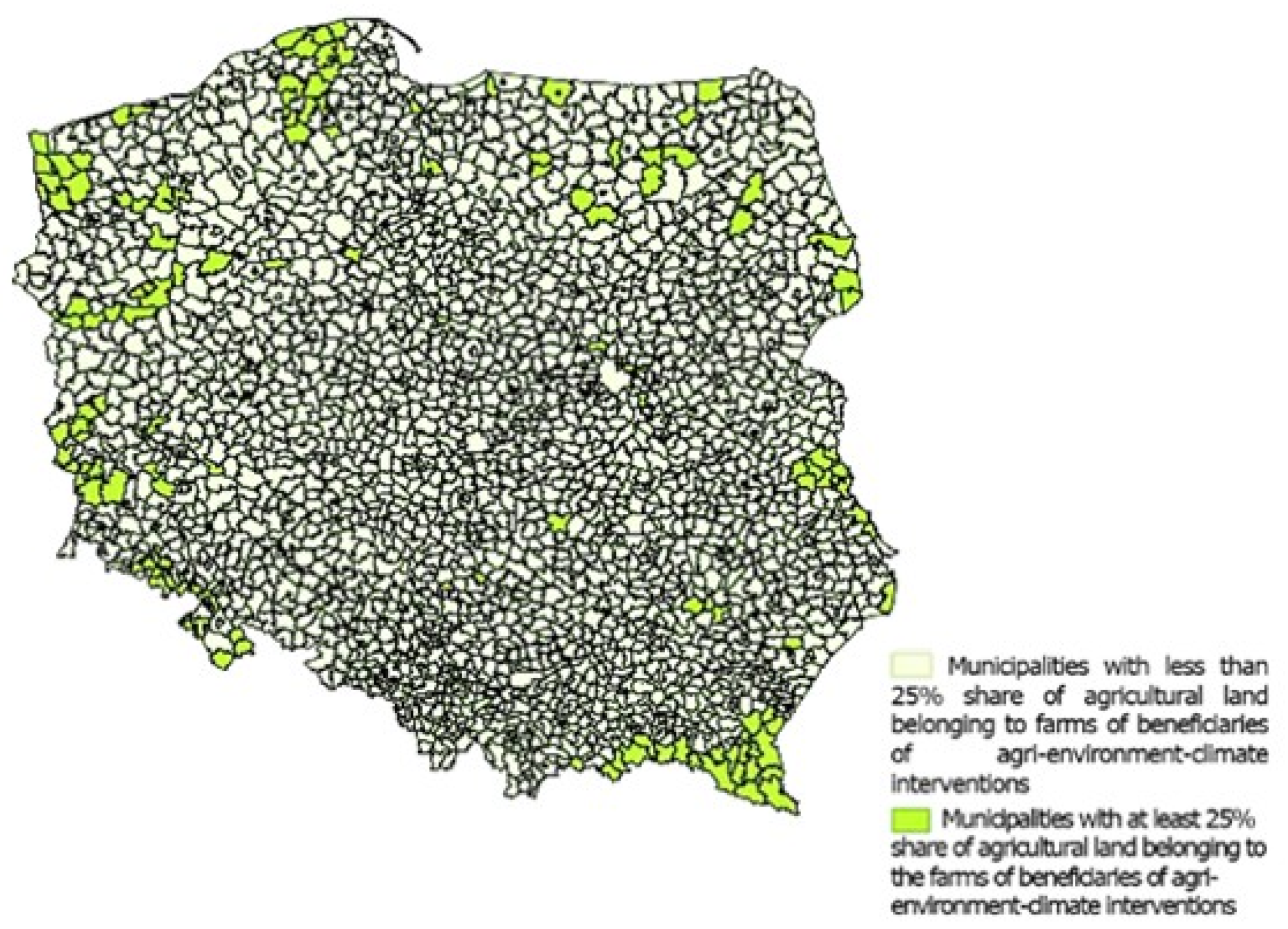

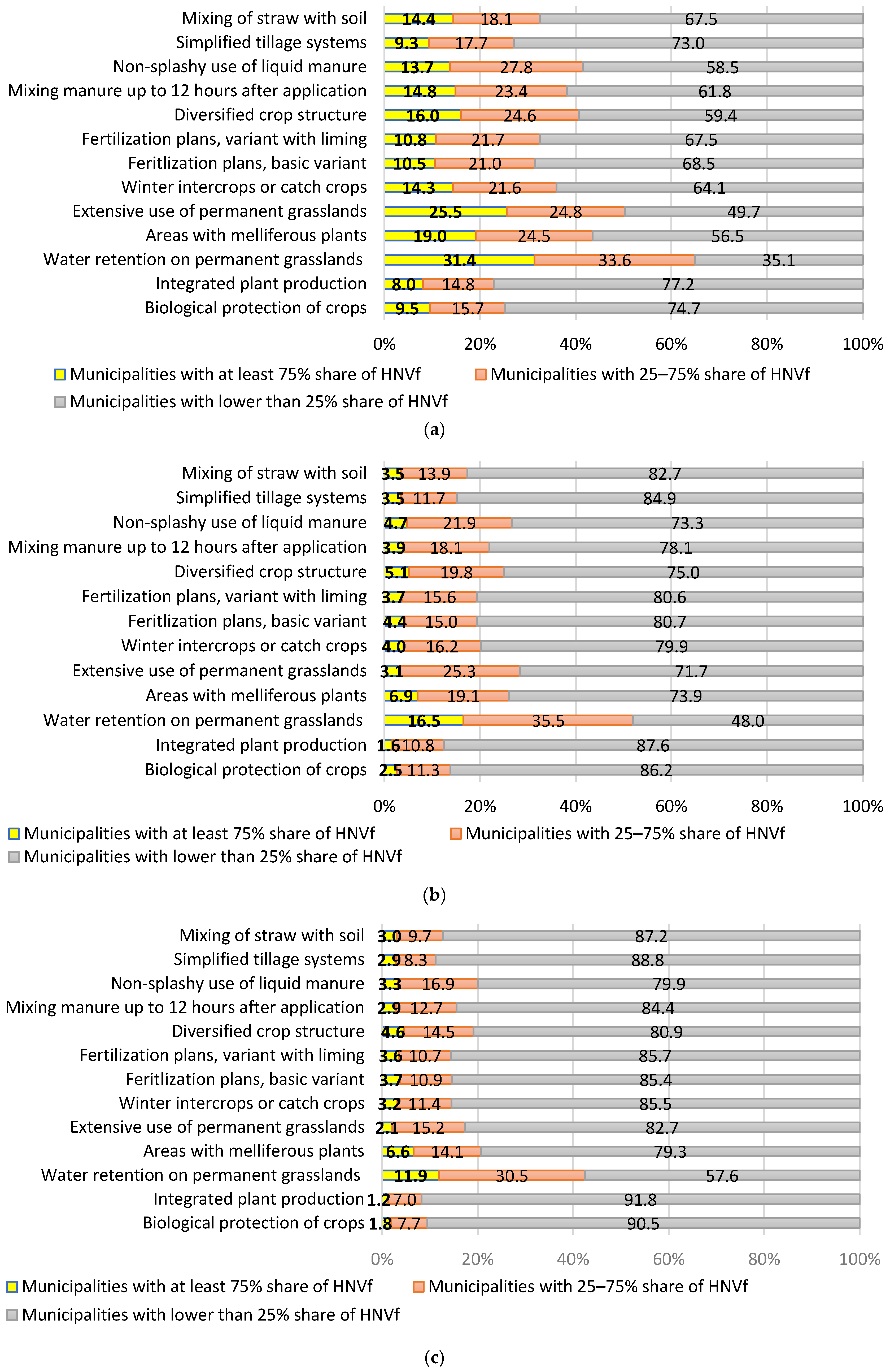
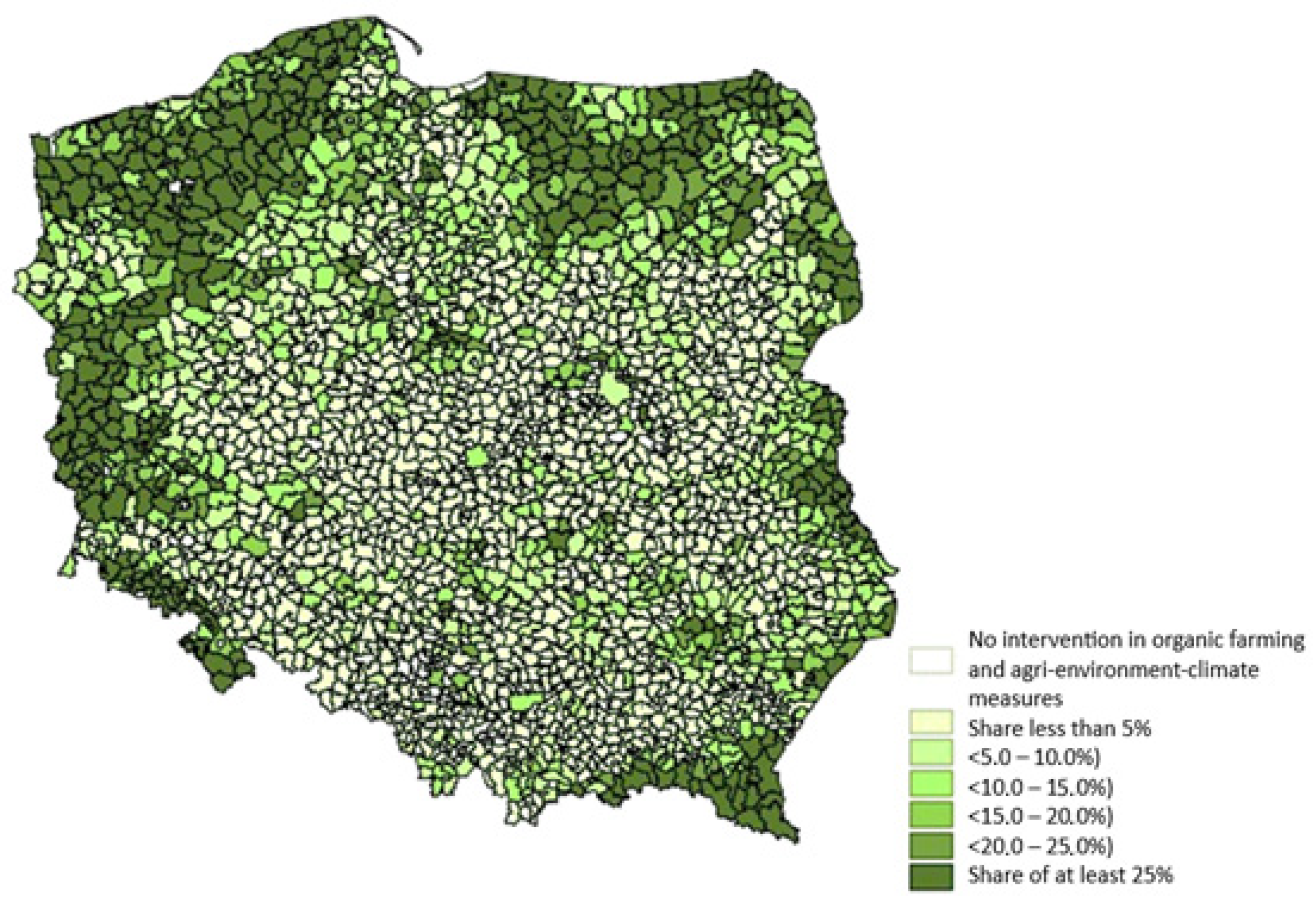
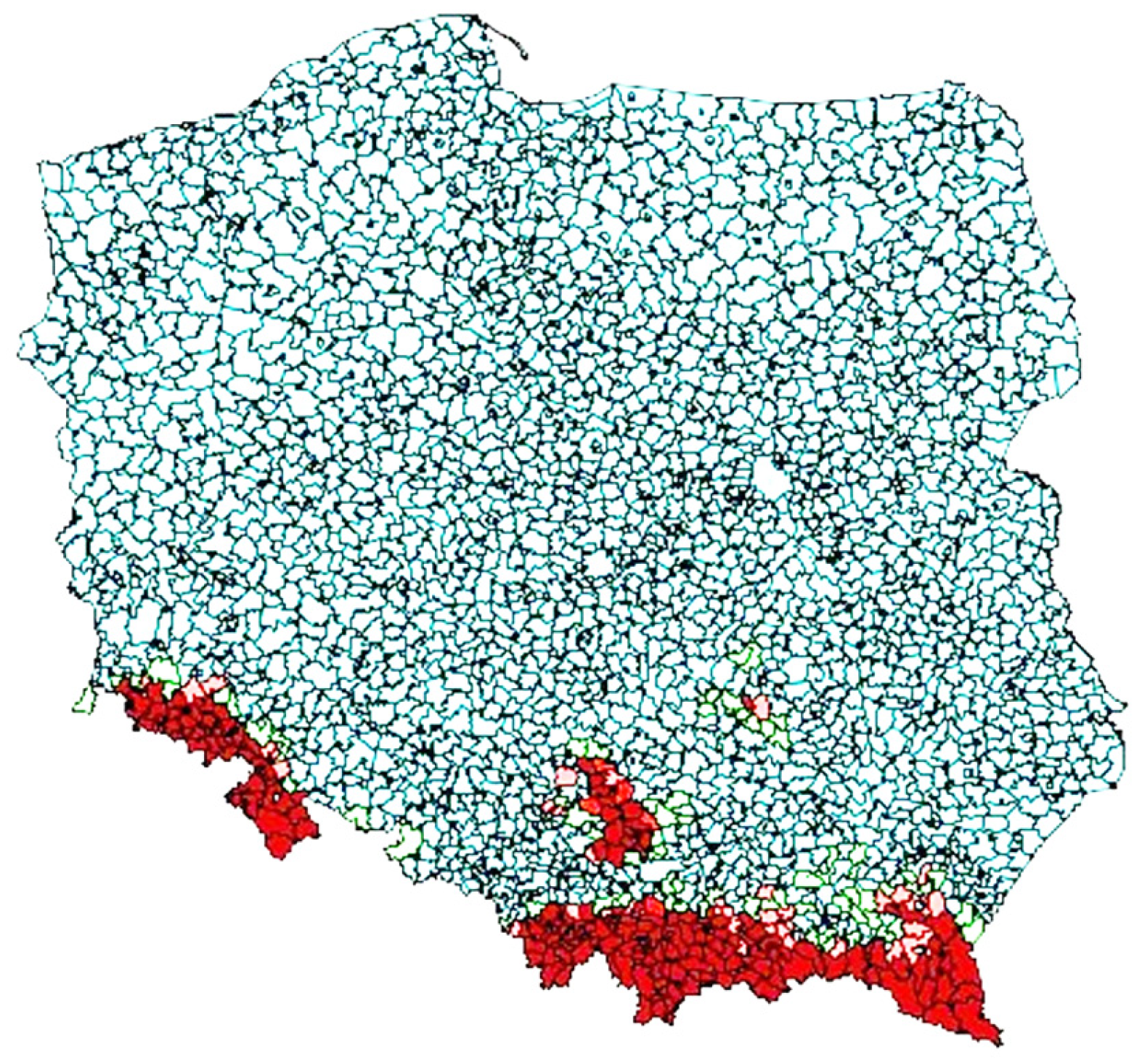
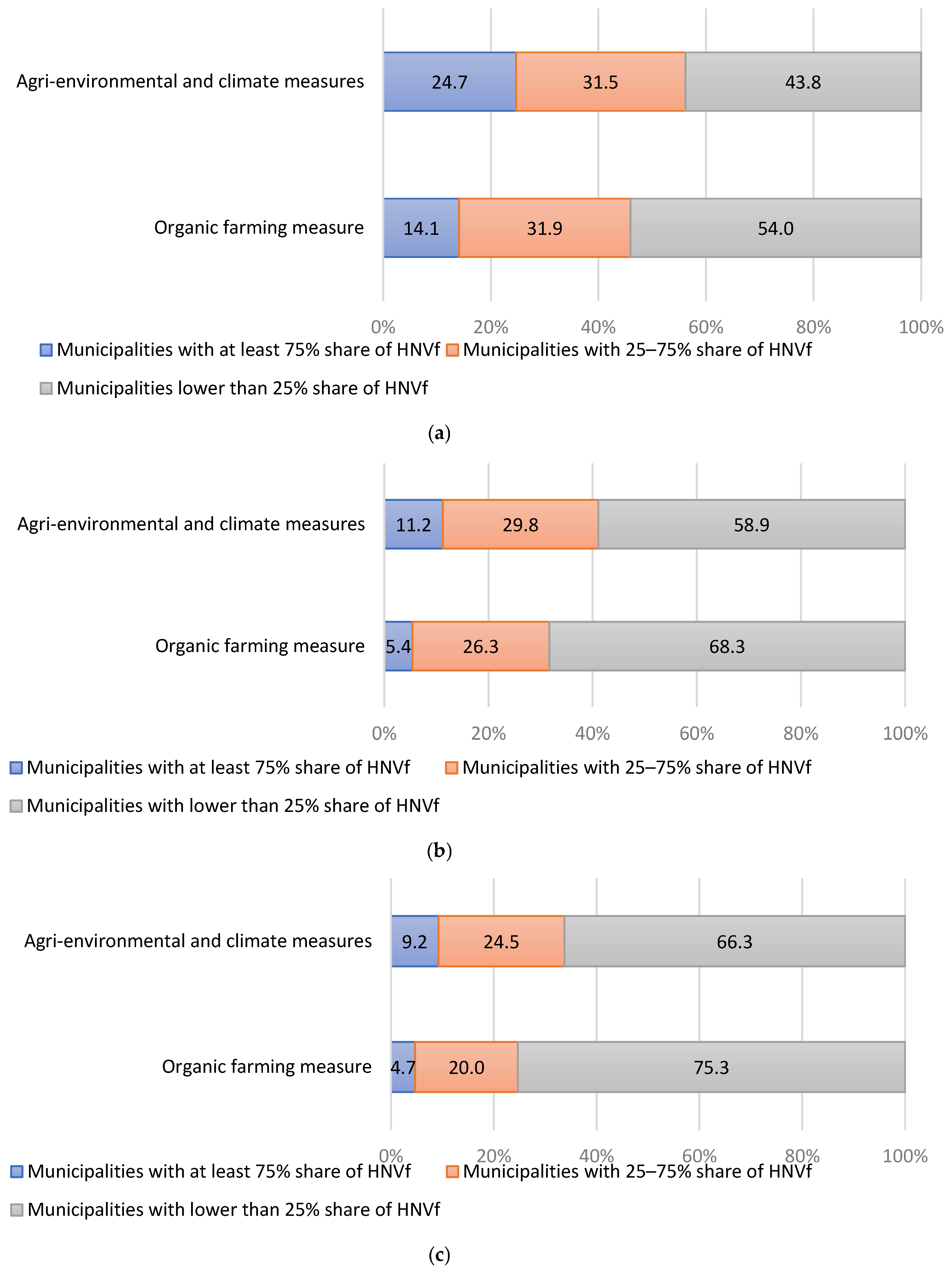
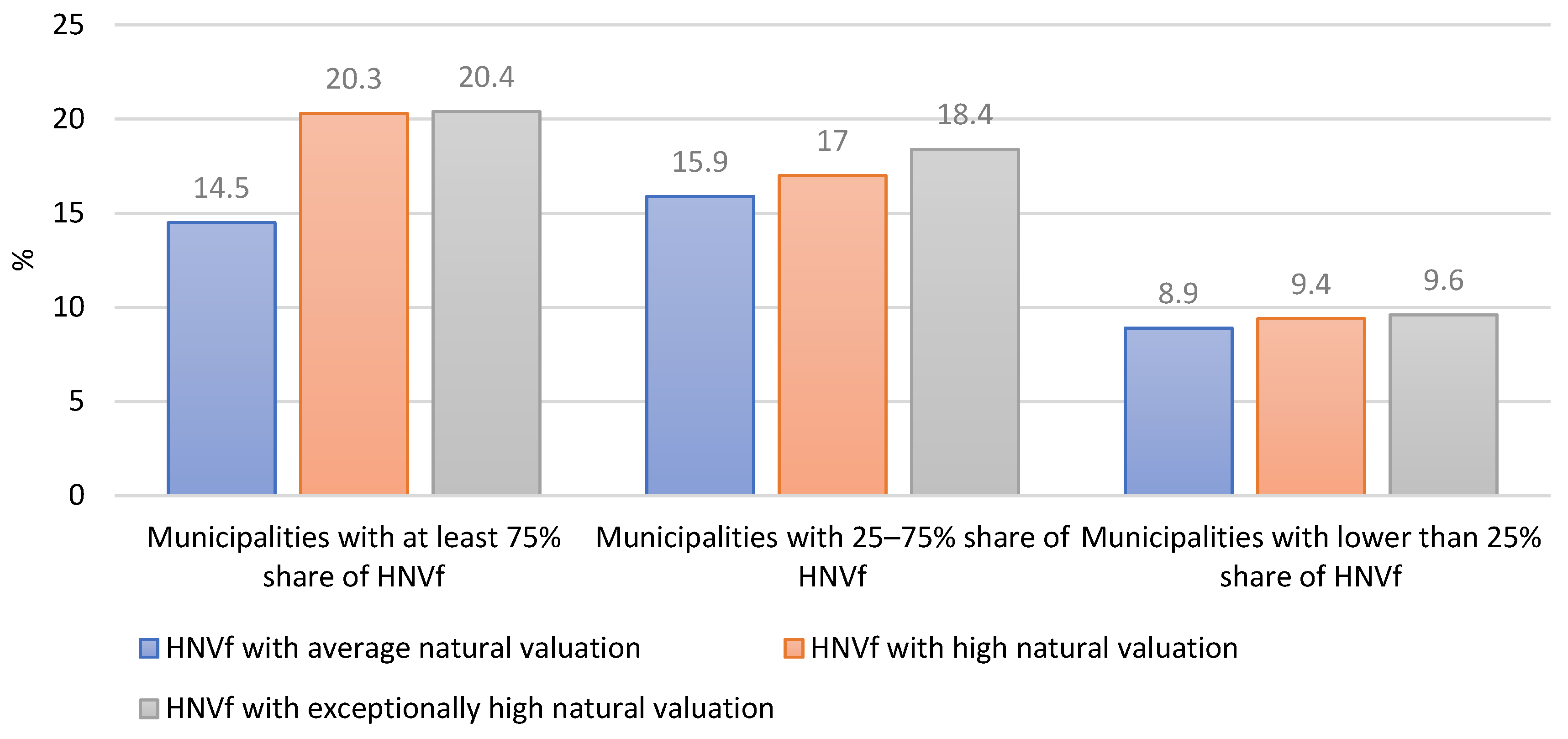
| Eco-Schemes/ Practices | 1. Carbon agriculture and nutrient management | 1.1 Extensive use of permanent grassland with stocking rates 1.2 Winter intercrops or catch crops 1.3 Development and respecting a fertilizer plan (basic variant) 1.4 Development and respecting a fertilizer plan (variant with liming) 1.5 Diversified sowing structure 1.6 Mix manure on arable land within 12 h of application 1.7 Application of natural liquid fertilizers by methods other than splashing 1.8 Simplified tillage systems 1.9 Mixing of straw with soil |
| 2. Areas with melliferous plants | ||
| 3. Water retention on permanent grassland | ||
| 4. Integrated plant production | ||
| 5. Biological protection of plants | ||
| Organic farming measures | ||
| Agri-environment-climate measures | ||
| Specification | Municipalities with at Least 50% Share of Agricultural Land Located on the Farms of Eco-Scheme Beneficiaries in the Total Area of Agricultural Land | Other Municipalities |
|---|---|---|
| Average share of farmland on farms of eco-scheme beneficiaries in farmland by municipality (%) | 65.0 | 36.7 |
| Total number of farms (thousands) | 665.3 | 569.0 |
| Share of farms of eco-scheme beneficiaries in the total number of farms (%) | 45.8 | 21.7 |
| UAA (thousand hectares), including % share: | 9950.9 | 4144.0 |
| - arable land (%) | 85.2 | 66.6 |
| - permanent grassland (%) | 13.8 | 27.3 |
| - fixed assets (%) | 1.0 | 6.1 |
| Average farm area (ha) | 15.0 | 7.3 |
| Share of ANCs in total UAA (%) | 52.7 | 70.1 |
| S–W Index (points) | 2.42 | 2.29 |
| Specification | Municipalities with at Least 25% Share of Agricultural Land Under Organic Farming Measure in Total Agricultural Area | Other Municipalities |
|---|---|---|
| Average share of farmland on the farms of beneficiaries of organic farming measures in total farmland by municipality (%) | 33.2 | 2.5 |
| Total number of farms (thousands) | 12.4 | 1221.9 |
| Share of organic farming beneficiary farms in the total number of farms (%) | 25.8 | 1.3 |
| UAA (thousand ha), including % share: | 314.3 | 13,780.6 |
| - arable land (%) | 72.5 | 80.0 |
| - permanent grassland (%) | 25.8 | 17.6 |
| - fixed assets (%) | 1.7 | 2.4 |
| Average farm area (ha) | 25.3 | 11.3 |
| Share of ANCs in total UAA (%) | 92.3 | 58.8 |
| S–W Index (points) | 2.51 | 2.36 |
| Specification | Municipalities with at Least 25% Share of Agricultural Land Under Agri-Environment-Climate Measures in the Total Area of Agricultural Land | Other Municipalities |
|---|---|---|
| Average share of farmland on farms of beneficiaries of agri-environmental and climate measures in total farmland by municipality (%) | 36.2 | 6.4 |
| Total number of farms (thousands) | 48.0 | 1186.3 |
| Share of farms of beneficiaries of agri-environmental and climate measures in the total number of farms (%) | 33.9 | 5.0 |
| UAA (thousand ha), including % share: | 750.0 | 13,344.9 |
| - arable land (%) | 51.2 | 81.3 |
| - permanent grassland (%) | 48.0 | 16.0 |
| - fixed assets (%) | 0.8 | 2.7 |
| Average farm area (ha) | 15.6 | 11.2 |
| Share of ANCs in total UAA (%) | 92.4 | 58.8 |
| S–W Index (points) | 2.28 | 2.37 |
Disclaimer/Publisher’s Note: The statements, opinions and data contained in all publications are solely those of the individual author(s) and contributor(s) and not of MDPI and/or the editor(s). MDPI and/or the editor(s) disclaim responsibility for any injury to people or property resulting from any ideas, methods, instructions or products referred to in the content. |
© 2025 by the authors. Licensee MDPI, Basel, Switzerland. This article is an open access article distributed under the terms and conditions of the Creative Commons Attribution (CC BY) license (https://creativecommons.org/licenses/by/4.0/).
Share and Cite
Zieliński, M.; Gołębiewska, B.; Jadczyszyn, J.; Adamski, M.; Tyburski, J. Importance of Environmental Measures Under the CAP 2023–2027 on High Nature Value Farmlands: Evidence from Poland. Sustainability 2025, 17, 7763. https://doi.org/10.3390/su17177763
Zieliński M, Gołębiewska B, Jadczyszyn J, Adamski M, Tyburski J. Importance of Environmental Measures Under the CAP 2023–2027 on High Nature Value Farmlands: Evidence from Poland. Sustainability. 2025; 17(17):7763. https://doi.org/10.3390/su17177763
Chicago/Turabian StyleZieliński, Marek, Barbara Gołębiewska, Jan Jadczyszyn, Marcin Adamski, and Józef Tyburski. 2025. "Importance of Environmental Measures Under the CAP 2023–2027 on High Nature Value Farmlands: Evidence from Poland" Sustainability 17, no. 17: 7763. https://doi.org/10.3390/su17177763
APA StyleZieliński, M., Gołębiewska, B., Jadczyszyn, J., Adamski, M., & Tyburski, J. (2025). Importance of Environmental Measures Under the CAP 2023–2027 on High Nature Value Farmlands: Evidence from Poland. Sustainability, 17(17), 7763. https://doi.org/10.3390/su17177763






